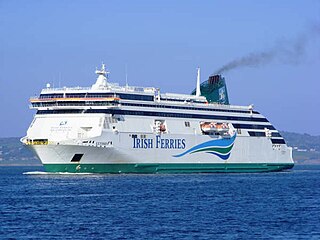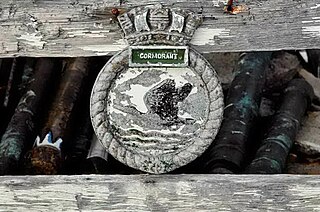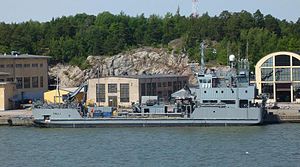
The Albion-class landing platform dock is a class of amphibious warfare ship in service with the Royal Navy. The class consists of two vessels, HMS Albion and HMS Bulwark, ordered in 1996 to replace the ageing Fearless class. Both ships were built by BAE Systems Marine at the former Vickers Shipbuilding and Engineering yard in Barrow-in-Furness. Albion was commissioned in 2003 and Bulwark in 2004. Each of the ships has a crew of 325 and can accommodate up to 405 troops. Thirty-one large trucks and thirty-six smaller vehicles and main battle tanks can be carried inside the vehicle deck. To disembark troops and vehicles, the vessels are equipped with eight landing craft.

The Oil Pollution Act of 1990 (OPA) was passed by the 101st United States Congress and signed by President George H. W. Bush. It works to avoid oil spills from vessels and facilities by enforcing removal of spilled oil and assigning liability for the cost of cleanup and damage; requires specific operating procedures; defines responsible parties and financial liability; implements processes for measuring damages; specifies damages for which violators are liable; and establishes a fund for damages, cleanup, and removal costs. This statute has resulted in instrumental changes in the oil production, transportation, and distribution industries.

A cargo ship or freighter is a merchant ship that carries cargo, goods, and materials from one port to another. Thousands of cargo carriers ply the world's seas and oceans each year, handling the bulk of international trade. Cargo ships are usually specially designed for the task, often being equipped with cranes and other mechanisms to load and unload, and come in all sizes. Today, they are almost always built of welded steel, and with some exceptions generally have a life expectancy of 25 to 30 years before being scrapped.

A deep-submergence vehicle (DSV) is a deep-diving crewed submersible that is self-propelled. Several navies operate vehicles that can be accurately described as DSVs. DSVs are commonly divided into two types: research DSVs, which are used for exploration and surveying, and DSRVs, which are intended to be used for rescuing the crew of a sunken navy submarine, clandestine (espionage) missions, or both. DSRVs are equipped with docking chambers to allow personnel ingress and egress via a manhole.

Marine debris, also known as marine litter, is human-created solid material that has deliberately or accidentally been released in a sea or ocean. Floating oceanic debris tends to accumulate at the center of gyres and on coastlines, frequently washing aground, when it is known as beach litter or tidewrack. Deliberate disposal of wastes at sea is called ocean dumping. Naturally occurring debris, such as driftwood and drift seeds, are also present. With the increasing use of plastic, human influence has become an issue as many types of (petrochemical) plastics do not biodegrade quickly, as would natural or organic materials. The largest single type of plastic pollution (~10%) and majority of large plastic in the oceans is discarded and lost nets from the fishing industry. Waterborne plastic poses a serious threat to fish, seabirds, marine reptiles, and marine mammals, as well as to boats and coasts.

The Galicia class are two landing platform dock (LPD) ships in service with the Spanish Navy. Built by Navantia at Ferrol, their mission is to carry out amphibious warfare by transporting the bulk of the Infantería de Marina. These ships have both a large helicopter flight deck and a 885-square-metre (9,530 sq ft) well deck for large landing craft, as well as a 1,000-square-metre (11,000 sq ft) space for up to 33 main battle tanks.

MV Ulysses is a RORO car ferry currently owned and operated by Irish Ferries. The ship was launched on 1 September 2000 at Aker Finnyards shipyard in Rauma, Finland and services the Dublin–Holyhead route.

Galicia (L51) is a Galicia-class landing platform dock (LPD) of the Spanish Navy and is the seventh ship to bear this name. She is the lead ship in her class. The vessel was constructed in Ferrol, Spain and launched in 1997 and commissioned in 1998. Galicia is tasked with transporting Spanish marines, humanitarian aid missions and general logistic support. The LPD has taken part in actions against piracy in the Indian Ocean and off the Somalian coast, provided humanitarian aid following hurricanes and tsunamis and provided support during the COVID-19 pandemic in Spain.

USAT Brigadier General M. G. Zalinski was a U.S. Army transport ship that served in World War II. It sank in 1946 in the Grenville Channel in British Columbia's Inside Passage. The crew were rescued by a tug boat and the SS Catala passenger steamer, but the cargo of bombs and oil went down with the ship.

HMCS Cormorant was a diving support vessel that served in the Canadian Forces. She was equipped with two SDL-1 submersibles. The ship was the first in the Canadian Forces to have women assigned to their crew. Initially constructed as the trawler Aspa Quarto in 1965, the ship was acquired by the Canadian Forces in 1975 and renamed Cormorant. The vessel remained in service until 1997 when Cormorant was sold to a US buyer. The ship was laid up at Bridgewater, Nova Scotia in 2000 and was removed on 18 November 2020 to be scrapped in Sheet Harbour.

The Caledonian MacBrayne fleet is the largest fleet of car and passenger ferries in the United Kingdom, with 34 ferries in operation, 2 on charter and another 6 on order. The company provides lifeline services to 23 islands off the west coast of Scotland, as well as operating routes in the Firth of Clyde.
Australian Submarine Rescue Vehicle Remora was a submarine rescue vehicle used by the Royal Australian Navy (RAN) between 1995 and 2006. The name comes from the remora, a small fish that can attach itself to larger marine life, and has the backronym "Really Excellent Method of Rescuing Aussies".

CCGS Tupper was a Canadian Coast Guard ice-strengthened buoy tender that served from 1959 to 1998. The vessel spent her entire career on the East Coast of Canada. Following her Canadian service, Tupper was sold to private interests with the intention of converting her to a yacht, but the conversion never happened and the vessel moved about Halifax Harbour, suffering a fire in 2008 before being sold for scrap in 2011. The vessel was not scrapped and the Canadian Coast Guard was forced to address the pollution concerns of the abandoned vessel in 2021.

Louhi is a Finnish multipurpose oil and chemical spill response vessel owned by the Finnish Environment Institute (SYKE), but crewed and operated by the Finnish Navy. The ship, ordered in 2007, was built by Uki Workboat in Uusikaupunki, Finland, and entered service in May 2011.

S. A. Agulhas II is a South African icebreaking polar supply and research ship owned by the Department of Environment, Forestry and Fisheries. She was built in 2012 by STX Finland Rauma shipyard in Rauma, Finland, to replace the ageing S. A. Agulhas, which was retired from Antarctic service in April 2012. Unlike her predecessor, S. A. Agulhas II was designed from the beginning to carry out both scientific research and supply South African research stations in the Antarctic.

Hylje (799) is a combined pollution cleanup ship and vehicle transport ship built in 1981 and refitted in 1990–1991. She is operated by a civilian crew from the Ministry of the Environment, but is under Finnish Navy control. The vessel can act as a landing ship and logistic support vessel. The vessel has a capacity to carry 100 tons of deck cargo and its bow ramp can unload vehicles up to 42 tons. The vessel is equipped with oil and oil-slurry collection tanks with a total capacity of 1,410 cubic metres (50,000 cu ft). The vessel can be operated in light ice. Hylje is equipped with a 6-ton crane.

MV Canadian Miner was a Canadian laker that was part of the fleet of Upper Lakes Shipping from 1994–2011. Initially constructed as Maplecliffe Hall in 1966, the ship was renamed Lemoyne in 1988 before becoming Canadian Miner in 1994. In 2011, the name was shortened to just Miner. In 2011 the vessel was taken out of service and sold for scrapping. While en route to the scrapyard in Turkey, the ship ran aground off Nova Scotia in 2011. The vessel was broken up in 2014 in Nova Scotia.

HMCS Margaret Brooke is the second Harry DeWolf-class offshore patrol vessel for the Royal Canadian Navy (RCN). The class was derived from the Arctic Offshore Patrol Ship project as part of the National Shipbuilding Procurement Strategy and is primarily designed for the patrol and support of Canada's Arctic regions. Named after Sub-Lieutenant Margaret Brooke, an RCN nursing sister who tried to save another person during the sinking of the ferry SS Caribou during World War II. Margaret Brooke was ordered in 2011, laid down in 2016 and launched in 2019. The vessel began contractor sea trials in May 2021, and it was delivered to the Royal Canadian Navy for post-acceptance sea trials on 15 July 2021. The official naming ceremony for the ship was conducted on 29 May 2022 in conjunction with that for sister ship Max Bernays. The vessel was commissioned on 28 October 2022.

The MV Wakashio oil spill occurred after the Japanese-controlled bulk carrier Wakashio ran aground on a coral reef on 25 July 2020 at around 16:00 UTC. The ship began to leak fuel oil in the following weeks, and broke apart in mid August. Although much of the oil on board Wakashio was pumped out before she broke in half, an estimated 1,000 tonnes of oil spilled into the ocean in what was called by some scientists the worst environmental disaster ever in Mauritius. Two weeks after the incident, the Mauritian government declared the incident a national emergency.

INS Sandhayak is the lead ship of her class of survey ships. It is a hydrographic survey ship built by GRSE for the Indian Navy.


















